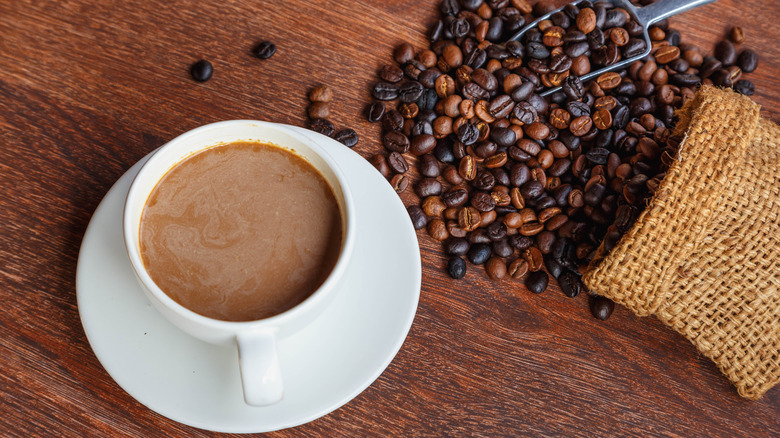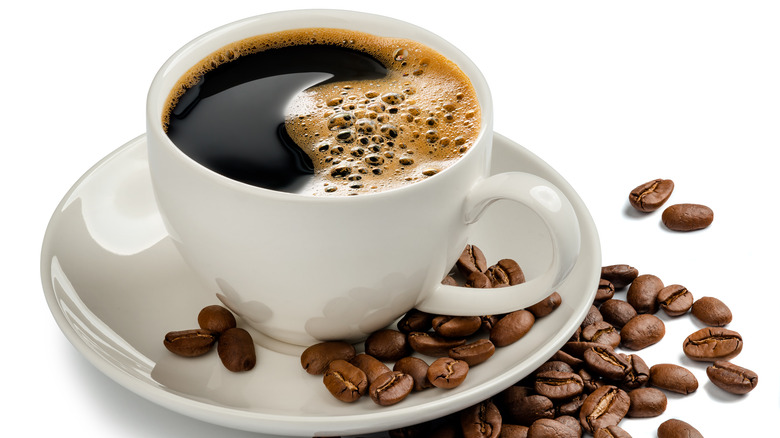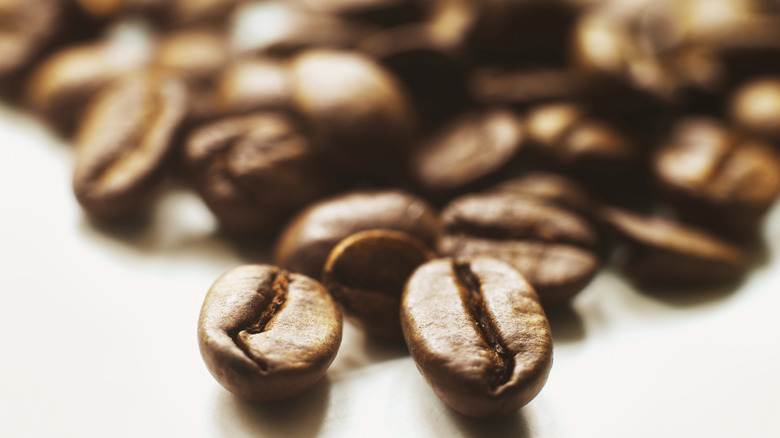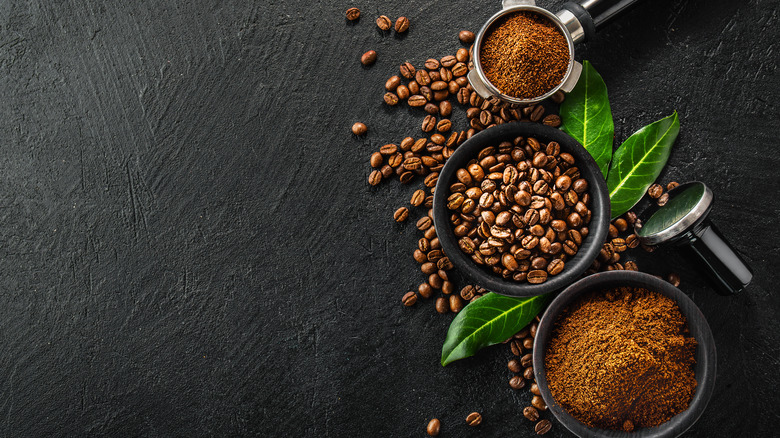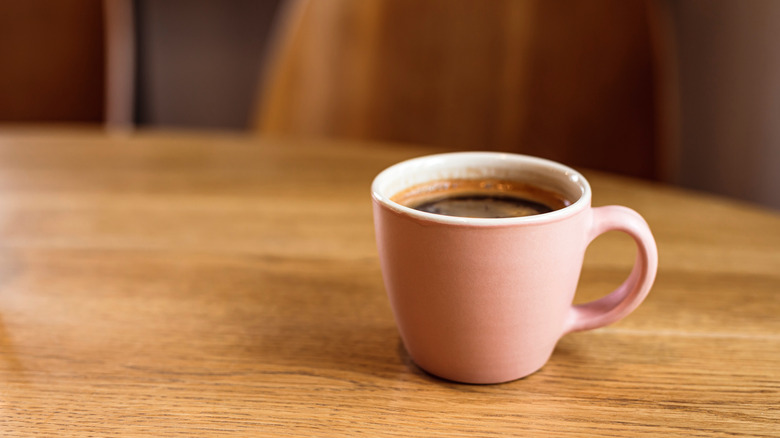How Is Coffee Decaffeinated?
Decaffeinated coffee doesn't exactly get a lot of love. When you see mugs that read things like "Death before decaf," it raises an important question: Do people simply want their coffee with caffeine, or is there something wrong with decaffeinated coffee? It turns out, that's not exactly a simple question to answer. The correct response is probably something along the lines of "Maybe?"
Coffee beans naturally contain caffeine, and how much each bean contains depends on the kind of bean you're talking about, according to Coffee Affection. There are two basic kinds of coffee beans: Robusta beans and Arabica beans. Arabica beans, which are generally considered higher quality and produce coffee that's more complex and less bitter, have about 6 milligrams of caffeine in every bean. A single Robusta bean contains about 10 milligrams of caffeine.
Those little coffee beans don't really want to relinquish the caffeine that's locked inside them, which makes the process of decaffeination a bit of a chore. There are four major ways in which coffee beans are decaffeinated, and all four take place pretty early in the coffee supply chain when the beans are still green and unroasted. As you might imagine, each of the four decaffeination processes impacts the flavor and character of coffee beans differently. Also, interestingly, decaffeinated coffee is just mostly decaffeinated, and the amount of caffeine left in coffee beans varies depending on the decaffeination method used, according to Coffee Affection. So what are these four decaffeination methods?
Direct solvent decaffeination
Direct solvent decaffeination is the oldest method of removing caffeine from coffee beans, though Coffee Review explains you won't see "direct solvent" on your bags or canisters of decaf coffee. Rather, you'll find "various euphemisms like European or traditional process." Why would you find a euphemism on a coffee label? Because the process of decaffeinating with a solvent doesn't sound terribly appetizing.
In direct solvent decaffeination, green, unroasted coffee beans are either steamed or soaked in water until they're softened (per Coffee Affection). Once the beans' pores have opened, a solvent is introduced, which "selectively unites with caffeine" (per Coffee Review). For direct solvent decaffeination, Coffee Affection explains that ethyl acetate, a substance that is naturally occurring in fruit, is the chemical most often used. After the long process — about 10 hours — of removing caffeine is complete, the coffee beans are steamed again to remove the solvent. Though ethyl acetate is the solvent of choice now, that wasn't always the case. Benzene used to be the solvent used to decaffeinate coffee, and its use was discontinued when it was discovered to be carcinogenic, according to Compound Interest.
Indirect solvent decaffeination
According to Coffee Affection, indirect solvent decaffeination is the most common process for removing caffeine from coffee beans today. In this process, coffee beans are boiled in water, which removes the caffeine. Along with the unwanted caffeine, however, come many of the compounds that give coffee its flavor, thus posing a bit of a dilemma. The water containing flavor compounds and caffeine is separated from the beans and introduced to a solvent — most commonly methylene chloride — which removes the caffeine.
Compound Interest, in their examination of the chemical process of decaffeination, explains that methylene chloride "removes most of the caffeine and less of the flavor compounds." The solvent is then removed from the water solution, and the coffee beans are reintroduced to reabsorb what's left of the flavor compounds. The major problem with both solvent methods is that some of the flavor is stripped from the beans in the decaffeination process. Though there may be some consumer concern about traces of the solvents being left in the coffee beans after they're decaffeinated, Coffee Review explains that's unlikely, due to the roasting process that follows decaffeination when the solvents are almost certainly volatilized.
Carbon dioxide decaffeination
Coffee Affection calls the third decaffeination method "the supercritical carbon dioxide process," which is both simpler and just as complicated as it sounds. Future Learn points out that carbon dioxide is usually a gas, or at very low temperatures, a solid, which we call dry ice. But when it's exposed to very high pressure, it becomes a liquid called a supercritical fluid, and this liquid can extract caffeine from green coffee beans that have been soaked in hot water.
The benefit of carbon dioxide decaffeination is that it doesn't strip flavors from coffee beans to the same degree that the chemical solvents do. The downside is the equipment is highly specialized, and therefore very expensive. In fact, Future Learn points out that the equipment and its specifications are so precise and expensive that carbon dioxide decaffeination only becomes economically feasible if the decaffeinating plant processes more than 3,000 tons of decaf coffee each year.
Swiss Water Process decaffeination
Swiss Water Decaffeinated Coffee Inc. Director of Marketing Erin Reed discussed how the company's decaffeination works with Tasting Table via email. According to her, it's a process designed for "minimizing the differences in the coffee before and after decaffeination." In short, green coffee is soaked in water, which removes everything that's water-soluble, including caffeine. This Green Coffee Extract (GCE) is then run through "proprietary carbon filters which specifically target and remove the caffeine."
This cycle is repeated until 99.9% of the caffeine has been removed, leaving only the flavor compounds in the GCE. The GCE is then introduced to a fresh batch of green coffee beans that have been soaked in water. Because the GCE doesn't contain caffeine, the caffeine from the beans diffuses into the GCE. Since only the caffeine is out of balance, the all-important flavor compounds stay right where they're wanted –- in the now-decaffeinated beans, which are dried, packaged, and shipped. Because the Swiss Water Process uses only water to remove caffeine from coffee beans, it's more environmentally friendly than other decaffeination methods (per Natural Force).
Why is decaffeinated coffee more expensive?
Regardless of the decaffeination method, the process of removing caffeine from green coffee beans is a specialized and expensive one, and it's frequently an add-on in terms of the cost of coffee beans. While some coffee manufacturers do have their own decaffeination plants, many send their beans away to be decaffeinated or purchase green beans that have already been decaffeinated, which can add to the expense of the finished, roasted decaf coffee (per Fresh Coffee House).
Because some decaffeination processes can also strip flavor out of the beans, decaf coffee can end up being both more expensive and less tasty. With the development of other techniques like the Swiss Water Process and carbon dioxide decaffeination that retain more flavor in the beans, it's possible to get a cup of decaf coffee that tastes more similar to its caffeinated counterpart. Of course, that flavor often still comes with a higher price tag.
